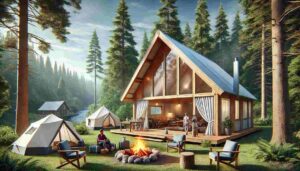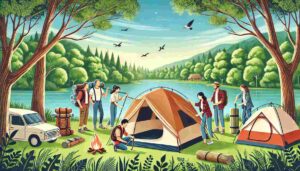Stationary RV living has gained popularity as an alternative lifestyle that combines the freedom of RV travel with the comforts and stability of a permanent home. Living in a stationary RV offers numerous advantages, such as the ability to explore different locations while maintaining a sense of community and familiar living space. In this article, I will explore the ins and outs of stationary RV living and provide you with valuable tips to make the most of this unique lifestyle. Whether you’re looking to downsize, embrace a minimalist lifestyle, or simply seek a change of scenery, stationary RV living can be an exciting and rewarding choice.
I’ll cover everything you need to know to embark on your stationary RV living journey. From selecting the right RV for your needs to finding the perfect location and setting up your living space. Additionally, I’ll address the challenges that may arise and offer effective solutions and tips to overcome them.
So, let’s dive into the world of stationary RV living and discover the tips and tricks that will help you make the most of this extraordinary experience.
Choosing the Right RV for Stationary Living
When it comes to stationary RV living, selecting the right RV is crucial to ensure comfort, functionality, and long-term satisfaction. Here are some essential considerations to keep in mind when choosing an RV for stationary living:
1. Size and Layout:
-
- Assess your space requirements: Determine how much living space you need and consider factors like the number of occupants, pets, and specific lifestyle needs.
- Optimize layout: Look for a floor plan that maximizes usable space and offers features like separate living areas, ample storage, and a functional kitchen and bathroom.
2. Amenities and Features:
-
- Evaluate your essential amenities: Make a list of must-have amenities such as a comfortable sleeping area, full kitchen appliances, bathroom facilities, and entertainment options.
- Consider additional features: Think about extras like slide-outs for extra living space, built-in storage solutions, air conditioning, and heating systems to enhance your comfort.
3. Quality and Durability:
-
- Research reputable brands: Look for RV manufacturers known for their quality construction, durable materials, and reliable craftsmanship.
- Inspect build quality: Examine the RV’s construction, including the roof, walls, and flooring, to ensure they are sturdy and built to withstand long-term use.
Remember to thoroughly research and visit RV dealerships or explore online resources to compare different models and find the one that best fits your needs and budget. Additionally, consider consulting with experienced stationary RV dwellers or joining online forums to gather valuable insights and recommendations.
Selecting an Ideal Location
Choosing the right location for your stationary RV living is a key factor in creating a fulfilling and enjoyable experience. Consider the following factors when selecting an ideal location:
- Climate and Weather Conditions:
- Assess your preferences: Determine the type of climate and weather conditions you prefer, whether it’s year-round warmth, mild seasons, or a specific climate that suits your lifestyle.
- Research locations: Look for areas known for their favorable climate and weather patterns that align with your preferences. Consider factors like average temperatures, rainfall, and extreme weather occurrences.
- Accessibility to Essential Services:
- Proximity to amenities: Ensure that the location you choose is close to essential services such as grocery stores, medical facilities, pharmacies, and other amenities that are important for your day-to-day needs.
- Infrastructure and utilities: Check if the location offers reliable access to utilities like electricity, water, sewage disposal, and internet connectivity.
- Safety and Security:
- Research crime rates: Look for locations with low crime rates and a reputation for safety to ensure your peace of mind.
- Evaluate security measures: Consider the security measures available in the area, such as gated communities, surveillance systems, and on-site security personnel.
- Proximity to Attractions and Amenities:
- Recreation and entertainment options: Consider the proximity of recreational activities and attractions that align with your interests, such as parks, hiking trails, beaches, cultural events, shopping centers, and dining options.
- Community engagement: Look for locations with a vibrant community that offers opportunities for socializing, participating in activities, and forming connections with fellow RV dwellers or residents.
When researching potential locations, take advantage of online resources, RVing forums, and social media groups to gather insights and recommendations from other stationary RV dwellers. Consider visiting the areas you’re interested in or renting a space temporarily to get a firsthand experience of the location before committing to a long-term stay.
Setting Up and Organizing Your RV
Setting up and organizing your RV is essential to maximize the available space and create a comfortable living environment. Consider the following tips to make the most of your stationary RV living space:
Tips for Optimizing Space and Storage:
- a. Decluttering and minimalism: Start by minimizing your possessions and keeping only what is essential. This will help create a clutter-free environment and maximize your available space.
- b. Utilizing vertical space: Make use of vertical storage solutions such as shelves, hanging organizers, and wall-mounted racks to maximize storage capacity without sacrificing floor space.
- c. Creative storage solutions: Invest in storage containers, collapsible furniture, under-bed storage, and multi-purpose items to make the most of every nook and cranny in your RV.
Essential Equipment and Accessories for Stationary RV Living:
- a. Utilities and hookups: Ensure you have the necessary hookups for electricity, water, sewage, and propane. Consider investing in surge protectors, water pressure regulators, and sewer hose supports for convenience and safety.
- b. Internet and communication setup: Explore options for reliable internet connectivity such as mobile hotspots, Wi-Fi extenders, or campground Wi-Fi subscriptions. Set up a communication system like a cell phone plan or a VoIP service for staying connected.
- c. Outdoor living essentials: Enhance your outdoor living space with patio furniture, awnings, outdoor rugs, and a portable grill. These additions will allow you to enjoy the surrounding environment and entertain guests comfortably.
Remember to personalize your RV space with decor and items that bring you joy, but be mindful of not overcrowding the interior. Keep in mind that weight distribution is crucial, so distribute the weight of your belongings evenly to maintain balance while on the move.
Establishing Routines and Embracing the Lifestyle
Living in a stationary RV requires establishing routines and embracing a unique lifestyle that blends adventure, flexibility, and a sense of community. Here are 3 tips to help you create a fulfilling routine and fully embrace the stationary RV living experience:
1. Creating a Daily Routine and Structure:
- a. Chores and maintenance: Establish a regular schedule for RV maintenance tasks such as cleaning, organizing, and performing routine checks on systems and appliances.
- b. Work and leisure balance: If you’re working remotely or have other commitments, create a designated workspace within your RV. Set boundaries and establish a schedule that allows for a healthy work-life balance.
- c. Engaging in community activities: Participate in community events, social gatherings, and activities offered in your RV park or surrounding area. This is an excellent way to meet fellow RV dwellers, build connections, and create a sense of belonging.
2. Discussing the Advantages of Stationary RV Living:
- a. Financial benefits: Emphasize the potential cost savings associated with stationary RV living, such as lower housing expenses, reduced utility bills, and the ability to choose affordable locations. b. Flexibility and mobility: Highlight the flexibility of stationary RV living, which allows you to change locations easily, explore new areas, and adapt your living environment based on your preferences.
- c. Connection with nature and community: Embrace the opportunity to connect with nature by spending time outdoors, enjoying the surrounding scenery, and participating in outdoor activities. Engage with the RV community and foster relationships with like-minded individuals.
3. Embracing a Minimalist Mindset:
- a. Simplify and declutter: Continually reassess your belongings and practice ongoing decluttering to maintain a minimalist lifestyle in your RV. Prioritize experiences and memories over material possessions.
- b. Focus on experiences: Embrace the freedom of RV living by prioritizing experiences and adventures. Explore nearby attractions, go hiking, take road trips, and immerse yourself in the local culture and activities.
Staying Comfortable and Sustainable
Maintaining comfort and sustainability in your stationary RV is essential for a pleasant and eco-friendly living experience. Here are 3 tips to help you stay comfortable and reduce your environmental impact:
1. Staying Comfortable:
- a. Insulation and weatherproofing: Enhance your RV’s insulation by sealing gaps, adding insulation to windows, and using draft stoppers. This helps regulate temperature and reduces energy consumption for heating and cooling.
- b. Heating and cooling options: Invest in efficient heating and cooling systems, such as electric or propane heaters, energy-saving air conditioners, or portable fans, to maintain a comfortable indoor climate throughout the year.
- c. Energy-efficient appliances: Choose energy-efficient appliances like LED lighting, low-energy refrigerators, and eco-friendly cooktops to reduce energy consumption and minimize utility costs.
2. Emphasizing Sustainable Living:
- a. Conserving water and electricity: Practice water-saving habits like taking shorter showers, fixing leaks promptly, and using water-efficient fixtures. Conserve electricity by turning off lights when not in use, utilizing natural light, and opting for energy-saving appliances.
- b. Recycling and waste management: Set up a recycling system within your RV and properly dispose of the waste following local guidelines. Minimize waste by opting for reusable items, composting organic waste, and avoiding single-use plastics.
- c. Using renewable energy sources: Explore the possibility of incorporating solar panels or portable solar generators to power your RV. This allows you to harness renewable energy and reduce reliance on traditional power sources.
3. Prioritizing Comfortable and Sustainable Materials:
- a. Eco-friendly materials: Choose sustainable materials for furniture, flooring, and decor. Look for options made from recycled or renewable materials, such as bamboo or cork flooring, organic fabrics, and reclaimed wood furniture.
- b. Indoor air quality: Opt for low-toxicity materials to maintain a healthy indoor environment. Select paints, adhesives, and cleaning products labeled as eco-friendly or low VOC (volatile organic compounds).
Overcoming Challenges of Stationary RV Living
While stationary RV living offers many advantages, it’s important to be aware of and prepared for the challenges that may arise. Here are some common challenges and strategies to overcome them:
Limited Space and Storage:
- a. Space-saving tips and organization hacks: Utilize vertical storage, invest in multi-functional furniture, and use collapsible items to maximize your available space.
- b. Regular decluttering: Regularly assess and declutter your belongings to prevent the accumulation of unnecessary items and maintain an organized living environment.
Building Connections and Community:
- a. Join RV clubs and online communities: Connect with other RV dwellers through social media groups, forums, and RV clubs. Attend meetups and gatherings to build relationships and share experiences.
- b. Engage in campground activities: Participate in campground activities, events, and communal spaces to meet fellow RVers and create a sense of community.
Dealing with Zoning and Legal Issues:
- a. Understand local regulations: Research and understand the zoning regulations and legal requirements related to stationary RV living in your chosen location.
- b. Seek legal advice if needed: If you encounter any legal challenges or have specific questions about regulations, consult with a lawyer or seek advice from local authorities.
Maintenance and Repairs:
- a. Regular maintenance: Establish a routine for inspecting and maintaining your RV’s systems, including plumbing, electrical, and mechanical components.
- b. Learn basic repairs: Equip yourself with basic repair knowledge and tools to address minor issues. Familiarize yourself with RV manuals and online resources for troubleshooting guidance.
- c. Consider professional assistance: For complex repairs or maintenance tasks, seek the assistance of qualified RV service providers or technicians.
Remember, challenges are a part of any lifestyle, but with proper planning, flexibility, and a positive mindset, you can overcome them and enjoy the many rewards of stationary RV living.
Conclusion
Stationary RV living is an exciting and fulfilling lifestyle that offers the perfect blend of adventure, comfort, and community. By choosing the right RV, selecting an ideal location, and setting up your living space efficiently, you can create a cozy and functional home on wheels. Establishing routines, embracing the advantages of this lifestyle, and overcoming challenges will allow you to fully immerse yourself in the stationary RV living experience.
Remember to prioritize comfort and sustainability by optimizing insulation, investing in energy-efficient appliances, and practicing eco-friendly habits. By doing so, you can create a comfortable living environment while minimizing your ecological footprint.
While challenges may arise, such as limited space, building connections, and navigating local regulations, with the right mindset and resources, you can overcome them and adapt to this unique lifestyle. Stay organized, engage with the RV community, and seek assistance when needed to ensure a smooth and enjoyable experience.
So, if you’re ready to embark on a life of adventure, flexibility, and community, consider stationary RV living as an option. Embrace the freedom, embrace the possibilities, and embrace the joy of this extraordinary lifestyle. Start your journey and create memories that will last a lifetime. Happy stationary RV living!
You might also like:










